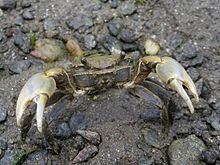| Helice tridens | |
|---|---|

| |
| Scientific classification | |
| Domain: | Eukaryota |
| Kingdom: | Animalia |
| Phylum: | Arthropoda |
| Class: | Malacostraca |
| Order: | Decapoda |
| Suborder: | Pleocyemata |
| Infraorder: | Brachyura |
| Family: | Varunidae |
| Genus: | Helice |
| Species: | H. tridens |
| Binomial name | |
| Helice tridens (De Haan, 1835) | |
| Synonyms | |
| |
Helice tridens is a species of crab which lives on mudflats around the coasts of Japan and the Korean Peninsula.
Ecology
It is semi-terrestrial, returning to the sea to spawn. The species appears to be adversely affected by the presence of raccoons (Procyon lotor), an invasive predator. H. tridens has a salinity requirement which lies between those of two other estuarine crabs in Japan, Helicana japonica and Chiromantes dehaani.
Smaller individuals shelter in burrows in reed marshes, apparently in order to avoid cannibalism; this may also be the reason for the migration of larger individuals to brackish water lagoons in summer, when the crabs exceed their carrying capacity.
Taxonomy
Helice tridens was first described by Wilhem de Haan in an 1835 volume of Fauna Japonica, as Ocypode tridens. The former subspecies H. t. wuana and H. t. sheni are now recognised as a separate species, Helicana wuana.
References
- "Helice tridens". Crabs of Japan. Retrieved January 31, 2009.
- ^ P. K. L. Ng, D. Guinot & P. J. F. Davie (2008). "Systema Brachyurorum: Part I. An annotated checklist of extant Brachyuran crabs of the world" (PDF). Raffles Bulletin of Zoology. 17: 1–286. Archived from the original (PDF) on 2011-06-06.
- Hsi-Te Shih & Hiroshi Suzuki (2008). "Taxonomy, phylogeny, and biogeography of the endemic mudflat crab Helice/Chasmagnathus complex (Crustacea: Brachyura: Varunidae) from East Asia" (PDF). Zoological Studies. 47 (1): 114–125. Archived from the original (PDF) on 2017-08-09. Retrieved 2010-03-27.
- ^ Hisayo Hayama, Masato Kaneda & Mayuh Tabata (2006). "Rapid range expansion of the feral raccoon (Procyon lotor) in Kanagawa Prefecture, Japan, and its impact on native organisms". In F. Koike; M. N. Clout; M. Kawamichi; M. De Poorter & K. Iwatsuki (eds.). Assessment and Control of Biological Invasion Risks (PDF). Shoukadoh Book Sellers, Kyoto, Japan and IUCN, Gland, Switzerland. pp. 196–199. Archived from the original (PDF) on 2011-07-22. Retrieved 2009-01-31.
- Bambang Irawan & Akihiro Kijima (1994). "Difference of salinity requirements among the three estuarine crab species, Chiromantes dehaani, Helice tridens and H. japonica (Brachyura: Grapsidae)" (PDF). Tohoku Journal of Agricultural Research. 44 (1–4). Archived from the original (PDF) on 2012-06-02. Retrieved 2009-01-31.
- Yasushi Kurihara, Katsuhiro Sekimoto & Masahide Miyata (1988). "Wandering behaviour of the mud-crab Helice tridens related to evasion of cannibalism" (PDF). Marine Ecology Progress Series. 49: 41–50. Bibcode:1988MEPS...49...41K. doi:10.3354/meps049041.
- Wilhem de Haan (1835). "Ocypode (Helice) tridens sp. nov.". In Philipp Franz von Siebold (ed.). Fauna Japonica. p. 57. Archived from the original on 2011-07-25. Retrieved 2009-01-31.
External links
 Media related to Helice tridens at Wikimedia Commons
Media related to Helice tridens at Wikimedia Commons
| Taxon identifiers | |
|---|---|
| Helice tridens | |
| Ocypode tridens | |